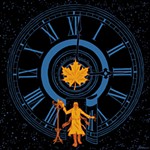Polytheism in the Raw
By Michael Ventura, Fri., Nov. 13, 1998
|
|
We forget now that these were the biggest human images people had ever seen (unless they had been to Egypt, where some statues were the size of buildings). And they moved. And, though they were silent, it seemed that you could hear them speak. To sit in a darkened hall, among many strangers, and watch the screen's full-moon-like light -- this was "entertainment" presented as a cultic rite, drama performed less as art than as a dream. It is not for nothing that, as early as 1915, Hollywood studios were called "dream factories."
We forget that, before the movies, for the most part only those actually participating in war and in riots saw murderous acts. We forget that in Europe and America privacy and propriety were such that "decent" people rarely saw anybody kiss -- at least not passionately, not in eavesdropping close-ups. Rituals of seduction have never been on public display (except in the sculpture of far-off places like India). When movies became the popular art, it was still considered provocative for women to show their ankles, even in the privacy of their homes. It wasn't unusual, in Europe and America, for married people to die without ever having seen one another completely naked. But in the first decades of this century, suddenly, and for mere pennies, these visions were available to all. The world was transfixed, enthralled, enchanted. It is no coincidence that by 1925, after a mere quarter century of movies, rigid social forms that had been in place for centuries began to break down. Cinema had released a tremendous raw energy into the world, and the old forms couldn't withstand the onslaught. The lid upon the human psyche had been torn off.
Cinema wasn't an "advance" upon theatre. The darkness of the cinematic experience, combined with the size and bright intensity of the movie image, is an experience more sensually primitive than theatre. We have no distance from the screen. Nor is cinema like the carefully orchestrated, tamed ritual of organized religion, the religion we may visit on the Sabbath. The anarchic intensity of movies is closer to the raw Dionysian energies of pagan and tribal rites that worship not God but gods, rites in which all sorts of extreme behaviors are not merely represented or referred to, but enacted.
By 1916, the most captivating of our screen images were being called "stars." We take that usage for granted now, applying it indiscriminately to anyone who manages to draw the limelight for a few months, but what inspired the usage in the first place? We saw the most charismatic of the players as more than human, as otherworldly, invested with powers that made them shine more brightly than earthbound creatures. In the same vein, the first cinema theatres were decorated with images of ancient divinities -- Chinese and Egyptian in L.A., Roman and Greek in New York. Film theatres were called "palaces" and "temples"; each theatre of one nationwide chain was actually called "The Paradise." They weren't invoking a Christian monotheistic paradise. The reference was to a form of religious belief that the West had thought itself too scientific, too progressive, too sophisticated, to entertain: polytheism in the raw.
At the same time, the likes of Greta Garbo and Gloria Swanson were first called "goddesses." Except for Charlie Chaplin -- whom writers instantly identified with the Great God Pan -- male stars were not called gods. I suspect because the God of the great monotheistic religions was seen as male. To call male stars "gods" would have struck too close to home, would have seemed too blasphemous -- and would have made what was really going on too obvious for comfort.
And what was going on? A form of ritual polytheism had returned to the "progressive" West with a force so unexpected, so overwhelming, that it is now the "entertainment" of all levels of our society. We've even invented a box to bring it into our homes, and that box has become the connective organ of our society. The only reason we took television into our homes was so that society's new gods, previously experienced only in public buildings, could become household gods. A family might have a crucifix on the wall, but they didn't watch the crucifix. The crucifix was taken for granted. They watched their favorite religious figures on the box.
Judaism, Islam, and Protestantism have no goddesses; Catholicism and Eastern Orthodox have the Virgin Mary and some demure saints -- dear sexless ladies, cautionary figures. Our hunger for a more lusty female iconography can be measured by how quickly we started calling first Clara Bow, then Jean Harlow, Marilyn Monroe, and Madonna, "sex goddesses" -- a form of sacred energy not officially sanctioned in the West for 1,500 years. Joan Crawford and Bette Davis are our Inanas and Demeters, goddesses of the Underworld. Katharine Hepburn and Meryl Streep are our Athenas. (Valentino and Brando and Elvis were versions of Dionysius. As John Wayne is our warrior-god, Chaplin and Robin Williams are our trickster-gods.) For the better part of a century now, they and their imitators have been visible, in the most extreme ways, on screens, billboards, magazine covers. Whatever we thought we were doing, our calling them "goddesses" and "stars" was and is anything but casual. We match the word with worship.
This is polytheism at its most overwhelming, worship at its most unconscious and influential. We may pay lip service to Jesus, Yahweh, Allah, and the Virgin Mary, but the very clothes upon our backs, the way we wear our hair, the way we speak, are shrines to the gods and goddesses of our modern polytheism. Their worship can be measured in the billions of dollars, in tickets and merchandise.
These gods and goddesses have the power to determine fashion, influence morality, impact what we perceive as the dimensions of human behavior, on a scale that the One God can only envy. No wonder that Christian, Jewish, and Moslem fundamentalists rail against the movies and TV. They're not stupid, they know a religious war when they see one -- while the sophisticated agnostics of the West don't even know they've constellated their lives around a new manifestation of ancient pagan worship. (In my profession, I've worked with many editors who insist they are not religious -- yet they base their editorial decisions involving what and whom to cover upon the demands of the new polytheism, the religion that they serve.)
In the beginning, most people saw the motion picture as a harmless toy that surely would not change the society in any fundamental way. No one guessed how quickly the projected image would displace literature, painting, organized religion, and politics as the emotional and psychological center of the modern sensibility. No one could have predicted that extreme behavior in extreme close-up would become the obsession of the civilized world -- and the standard by which most people would measure themselves. It is no wonder that after a century of unconscious yet devout worship of gods and goddesses long thought dead, what we once thought of as morality is everywhere in ruins; or that more and more our lives can be described in terms of the wild and anarchic cavortings of ancient deities.
And thank God. How confining it was to have to emulate a god stuck to a stick, or a goddess (his mother) who rarely smiled and certainly never laughed. There is not, in all the churches of Christendom, one image of Mary laughing -- or Jesus or Moses either for that matter. How can we truly feel made in the image of a god who never laughs, when laughter is often all thatreally saves us? So, without calling it a religion, we have welcomed the old gods back -- or they have sought us out, tired of being degraded by the mirthless and sexless gods and goddesses of our churches. We worship them with money, with imitation, with endless hours of attention. The other gods inspire conflict and wars to stay alive, stay important. The gods we really worship have only to smile. Or take off their clothes.









